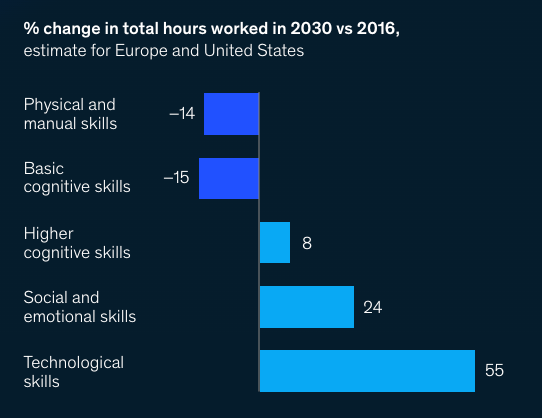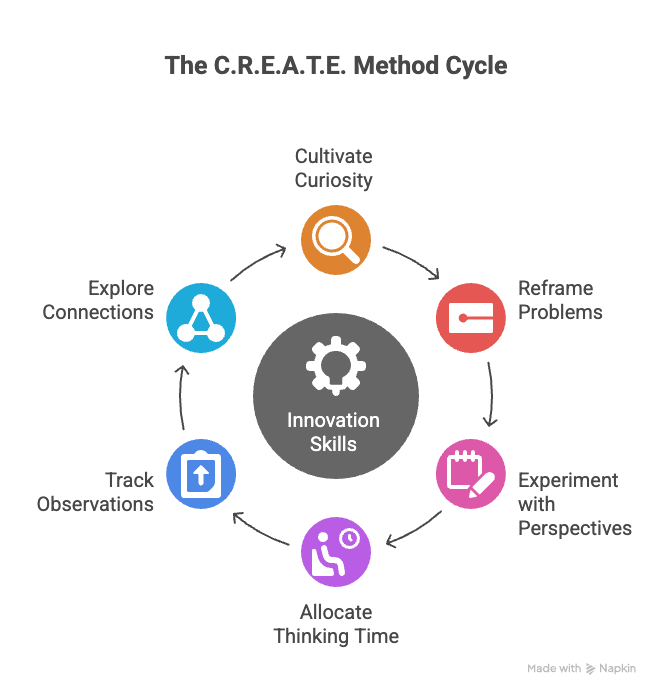Are You Developing the Most In-Demand Skills of the AI Revolution?
How to future-proof your leadership by developing the two skills that separate humans from AI
Thanks for reading! To access our community, full prompt library, coaching, and AI tools saving leaders 5-10 hours per week, check out our Premium Hub.
Have you ever watched a world-class chef work alongside their prep team?
The prep cooks can dice vegetables with machine-like precision, measure ingredients to the gram, and execute every technique flawlessly. They're masters of execution. But only the chef can taste something and say, "This needs a completely different approach" or "What if we combined flavors no one has tried before?"
That's the line being drawn in business right now between humans and AI.
AI has become like the ultimate prep team for leaders. It can…
Execute a customer service search faster than your best support agent, finding the exact help article in seconds.
It can code 70% of your MVP before lunch, turning your rough idea into working software.
It can plan your entire 7-day Italy trip with perfect restaurants, optimal routes, and budget breakdowns that would take your assistant hours to research.
But AI still can't taste the idea and know it needs salt.
While most leaders are still trying to perfect their execution skills, competing with technology that's already better at implementation than humans will ever be, the real question is different entirely:
Are you developing the right skills to succeed in the next decade?
Because in this AI revolution, creativity and innovation aren't just valuable leadership qualities anymore. They're the only skills that separate the leaders who thrive from those who get replaced by their own tools.
The Skills Demand Shift Is Accelerating
The numbers don't lie. According to McKinsey research, 37% of HR professionals report their biggest missing skill gap is "problem solving, critical thinking, innovation and creativity." Not technical skills. Not process management. Creative thinking.
Meanwhile, social and emotional skills demand is projected to grow 24% by 2030, while physical and manual skills decline by 14%. But here's what most leaders miss: this isn't a gradual shift happening over the next decade. It's happening right now, in real time.
Why Execution Skills Are Becoming More Easily Replaceable
Let me be direct about something most leadership development programs won't tell you: your execution skills are becoming more easily replaceable faster than you think.
Not because execution doesn't matter, but because AI is often better at it than humans. In my work with mission-driven leaders, I see this pattern everywhere:
Customer Service: Chatbots now handle complex inquiries with unlimited patience, perfect recall of customer history, and access to every help article instantly. They don't get frustrated, don't need breaks, and never give inconsistent answers.
Software Development: GitHub Copilot and similar tools now generate 40-60% of code for participating developers. Some report up to 70% productivity gains in MVP development. The execution of your idea into working software happens in hours, not months.
Content Creation: AI can draft emails, write reports, create presentations, and proofread content faster than your communications team. It doesn't have writer's block, doesn't need inspiration, and works 24/7.
The pattern is clear: anything that involves following established processes, optimizing known variables, or executing predefined steps is increasingly being automated.
But here's what AI still struggles with: knowing which problems are worth solving in the first place.
The Two Skills Where Humans Still Have the Advantage
While AI excels at execution, two distinctly human capabilities remain difficult to replicate:
1. Creative Problem Identification
AI can solve the problems you give it. It struggles to identify problems that haven't been clearly defined.
When I work with leaders, the breakthrough moments don't come from better execution. They come from someone asking, "Wait, are we solving the right problem?"
The ability to see what others miss, question what everyone accepts, and identify opportunities that don't yet exist. This is where human creativity still has a clear advantage.
2. Innovation Through Connection
AI processes information in patterns it's been trained on. Humans create innovation by connecting seemingly unrelated ideas, drawing from personal experience, and making intuitive leaps that logic alone can't explain.
The capacity to combine insights from different domains, apply lessons from one context to another, and create solutions that didn't exist before, remains a distinctly human strength.
The C.R.E.A.T.E. Method for Innovation Skills
If creativity and innovation are increasingly valuable, how do you actually develop them? Here's my framework based on working with hundreds of mission-driven leaders:
C - Curiosity Over Efficiency
Before your next decision meeting, spend 10 minutes asking "What problem are we not seeing?" instead of "How do we get this done faster?" Whether you're planning a product launch, organizing a church event, or managing your solo business, the goal isn't to complicate simple issues; it's to ensure you're applying your limited resources to challenges that actually matter.
R - Reframe Problems Before Solving Them
Innovation happens when you see your situation from angles others miss. Take your current biggest challenge and describe it from three perspectives: your audience (customers/congregation/clients), your competition (or others doing similar work), and someone from a completely different field.
E - Experiment with Perspective Shifts
Start a "notice journal." Every day, write down one thing you observed that others might have missed. A shift in team/volunteer energy. An unexpected comment from someone you serve. A process that works in one area of your work but fails in another.
A - Allocate Thinking Time
Creativity requires mental space that execution doesn't. When you're constantly responding to messages, jumping between tasks, and putting out fires, you're operating in execution mode.
Block 90 minutes each week for "thinking time." No agenda, no specific outcome required. Just space to let your mind make connections it can't make when you're rushing from task to task.
T - Track Unexpected Observations
Create a "pattern detection" system. Once a month, review your notice journal and look for recurring themes. Are there similar complaints from different areas? Do certain types of solutions keep failing? Are there opportunities that keep appearing but you haven't acted on?
The goal is to spot trends before they become crises and identify opportunities before your competition does.
E - Explore Cross-Industry Connections
Every quarter, study how a completely different industry solves problems similar to yours. If you're in retail, look at hospitality. If you're in ministry, study entertainment. If you're in tech, examine healthcare processes.
Ask yourself: "What would Disney do?" or "How would Amazon handle this?" or "What would a hospital do in this situation?" The best innovations often come from adapting solutions that work brilliantly elsewhere.
This isn't theoretical. Here's how creative thinking changes your actual leadership decisions:
Instead of asking: "How can we execute this project faster?"
Ask: "What if this entire approach is solving the wrong problem?"
Instead of asking: "How can we improve our current process?"
Ask: "What would we do if we were starting from scratch today?"
Here’s a prompt to get you started.
Sidenote: This is a sample of the prompt library available in the Premium hub to all Paid subscribers.
💡 Copy-Paste Prompt:
I'm a [insert: solopreneur/church leader/startup founder/team manager/department head] working to strengthen my critical thinking and innovation skills. Help me develop these capabilities by creating a personalized training plan that includes:
1. Three specific exercises I can practice this week to improve creative problem identification in my specific context
2. A framework for connecting ideas across different industries that could apply to my work
3. Questions I should ask myself daily to build stronger innovative thinking patterns
4. A 30-day challenge that progressively builds my creative leadership muscles, with weekly milestones I can track
Keep the exercises practical, measurable, and designed to build long-term creative thinking habits that work whether I'm leading a team of 2 or 200.The Leadership Advantage of Creative Thinking
When you develop strong creative thinking skills, something interesting happens to your leadership. You stop reacting to your environment and start shaping it.
The leaders who thrive in the next decade won't be the ones who can execute faster than AI. They'll be the ones who can envision futures that AI never would have considered, identify problems that don't show up in data, and create solutions that connect human needs in ways technology alone cannot.
This is especially crucial for mission-driven leaders. Your cause needs more than efficient execution. It needs someone who can see possibilities others miss, question assumptions others accept, and create pathways others haven't imagined.
Ready to build these skills systematically? Start with one "notice journal" entry today and see what you discover about your own creative blind spots. For leaders ready to develop systematic innovation processes, my Premium Member Hub offers advanced frameworks that turn creative thinking into a competitive advantage.
If You Only Remember This
AI increasingly handles execution tasks - making creativity and innovation increasingly valuable human skills
Creative problem identification matters more than solution optimization when AI can execute most solutions you define
The C.R.E.A.T.E. Method provides a systematic approach to developing innovation skills
Thinking time is not luxury time - it's the space where breakthrough ideas emerge
Further Reading:
"A Whole New Mind" by Daniel H. Pink - Essential reading on right-brain thinking in an automated world
"The Innovator's Dilemma" by Clayton Christensen - Understanding how creative disruption actually works
PS: Many subscribers get their Premium membership reimbursed through their company’s professional development $. Use this template to request yours.
Let’s Connect
I love connecting with people. Please use the following connect, collaborate, if you have an idea, or just want to engage further:
LinkedIn / Community Chat / Email / Medium
Affiliate links used for books







Spot on! Execution is AI’s domain, but identifying the right problems and connecting ideas across industries is where human leaders shine.
For more AI trends and practical insights, check out my Substack where I break down the latest in AI.
great insight, focusing on creativity and problem identification over pure execution is a powerful shift.
It's the uniquely human touch that will truly matter in the long run.